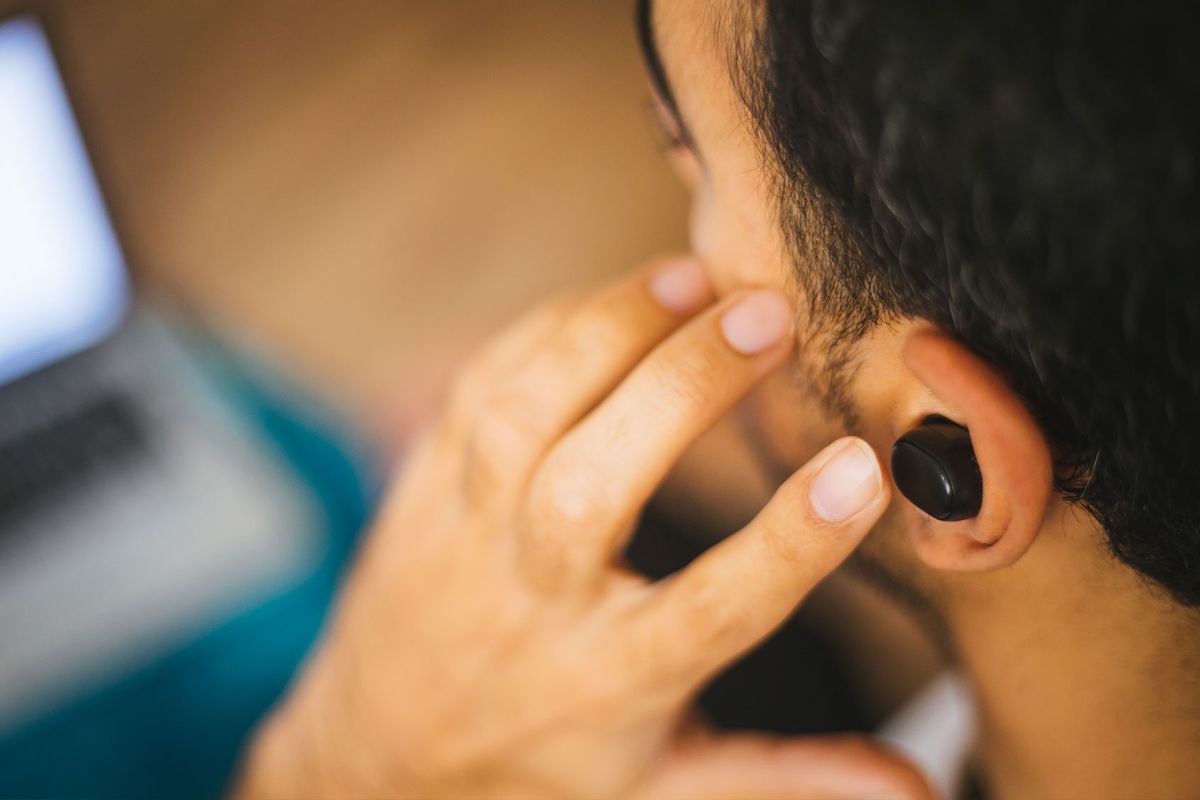Take out those earbuds — they’re wrecking your hearing

My teenaged daughter sleeps with her earbuds. Every night, she nestles in to her bed and heads to dreamland with an endless scroll of TikToks streaming straight into her head. “That can’t be good,” I think. And then in the morning I head out the door, plonk my own earbuds in, and crank up the volume to drown out the breakdancers and mariachi bands on the subway, the jackhammers on the street and the sirens whizzing by. I used to reflexively watch TV with closed captioning to enhance my ability to catch overlapping dialogue or subtle accents. But lately, as I lean a little closer to the screen with every episode of “Jeopardy!” and press the volume a notch higher, I’m starting to wonder if, in trying to muffle the cacophony of my daily life, I’ve only created a worse problem.
There has in recent years been robust debate about whether sound from earbuds is worse for your hearing than other forms of noise. Speaking with the New York Times last summer, University of Colorado Hospital audiologist Cory Portnuff said, “The misconception stems from the thought that, because an earbud sits farther into your ear, it would do more damage than something that sits farther away. What actually matters is the volume at your eardrum, not where it comes from.”
What is certain, however, is that hearing loss is a pervasive, and often ignored, problem. The National Institute on Deafness and Other Communications Disorders estimates that “5% of American adults (37.5 million) aged 18 and over report some trouble hearing.“ While hearing loss is far more prevalent in older adults, a BMJ Global Health study released this past fall estimated that “.67–1.35 billion adolescents and young adults worldwide could be at risk of hearing loss from exposure to unsafe listening practices… Damage from unsafe listening can compound over the life course.”
Earbuds make it insidiously easy to set yourself up for greater risk of hearing loss. And the damage isn’t just bad for the obvious reasons. It can set in motion other serious health issues, including, as Johns Hopkins Medicine points out, balance issues and brain atrophy. Hearing loss also contributes to social isolation, and haven’t we all had quite enough of that for a lifetime already?
“With most headphones at 80-100% volume routinely exceeding 100 dB, it’s important for people, and especially younger people, to be more aware of how long they’re exposing themselves to loud sounds.”
As someone who has always lived in cities and spent most of her teens and twenties parked directly in front of the band’s speakers, I only ever really distinguished two types of sounds — the kind I didn’t want to hear and the kind I did. I absolutely never gave a thought to my auditory health. If I want to, I can keep a constant hum of those invited noises right in my ear for hours at a time, all while also feeling like I’m graciously being non-intrusive to others. I go for long runs with old school jams blasting over the pounding of my heart. I putter through my chores while Ben Miles takes me through the rise and fall of Thomas Cromwell. I enjoy a full season of a murder podcast through a lengthy commute. All the while, it is way too easy to never turn the volume down, or never turn it off at all. Unfortunately for my ears — and yours — they don’t actually care whether it’s a car alarm or a Hilary Mantel novel that’s intruding in there. So I’m likelier to endure a higher level of noise and duration of damaging sound, because dammit, I’m enjoying it. I’m also setting a terrible example for my teen.
At the 2021 annual meeting of the Acoustical Society of America, researchers discussed the need for education efforts “to prevent an imminent noise-induced hear loss epidemic when today’s younger generations reach midlife.” Dr. Daniel Fink of the Quiet Coalition told Healthline at the time, “Especially for young people… personal audio system use is the major source of leisure noise exposure [When] they reach midlife, probably in their early to mid-forties, they will be as hard of hearing as their grandparents are now in their seventies and eighties.”
“Listening to sounds of 100 dB or more for over half an hour can cause permanent damage to hearing,” explains Dr. Daniel S. Troast, Doctor of Audiology at HearUSA. “With most headphones at 80-100% volume routinely exceeding 100 dB, it’s important for people, and especially younger people, to be more aware of how long they’re exposing themselves to loud sounds and to either reduce the volume, take breaks, or wear hearing protection to help reduce potential hearing loss.”
Want more health and science stories in your inbox? Subscribe to Salon’s weekly newsletter The Vulgar Scientist.
Because I tend to lose or destroy everything, I have long resisted investing in noise-canceling headphones. But I may be making a bad bet, because every time a guy with a trumpet steps into my subway car, I reflexively toggle the volume way up on my phone. “In order to reduce potential hearing damage,” suggests Troast, it’s important to know what type of headphones you’re using and what their capabilities and limitations are. While only noise-canceling headphones can efficiently eliminate all outer noise, other headphones, like earbuds, are not designed to eliminate ambient noise. Turning up the sound on regular headphones to a level that blocks out everything else is too loud and can result in hearing damage.”
How can you avoid positioning yourself for hearing damage? Audiologist Dr. Amy Sarow advises, “The best way to prevent the volume from exceeding a safe level is by limiting the device’s maximum output through the phone settings or avoiding turning the volume up past 70% of the full volume. A good rule of thumb: if you can’t hear someone talking to you at arm’s length over the volume, it’s too loud.”
Recently, for the first time ever, I looked at the hearing information on my phone’s health app, and was legitimately astonished to learn my headphone levels over the past month never went above 88 dB, earning me a hearty “OK” rating. But I know it’s better for my ears and my brain to take a more active role in lowering the volume. I have turned on the headphone safety option on my phone to reduce sounds above 100 decibels. I’ve asked for noise-cancelling headphones this holiday. I’m even trying to put my phone away and embrace the pleasures of silence where I can find it. I may not be able to control the musicians on the A train, but for the sake of my hearing, I can choose not to sonically compete with them.
Read more
about hearing health


